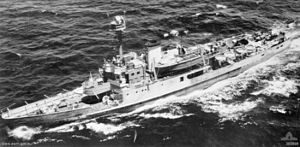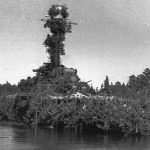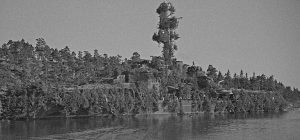 In the midst of World War II, February 1942, to be more exact, the Japanese fleet gave the combined Dutch-American-Australian-British fleet a beating that almost wiped them out completely, during the Battle of the Java Sea. The defeat brought about the Japanese occupation of the entire Netherlands East Indies. After the battle ended, only four Dutch warships were left in the Dutch East Indies. They knew there was no way they would be able to take down the Japanese fleet by themselves, so they decided to try to escape to Australia. The failed attempt left three of the four ships sunk, and one in hiding. The problem they had, was that the seas were full of warships and the skies were swarming with Japanese planes. It was going to be virtually impossible to sail the 1,000 miles of ocean to safety. The HNLMS Abraham Crijnssen, which was the last ship, had a big problem, for which they found a crazy solution.
In the midst of World War II, February 1942, to be more exact, the Japanese fleet gave the combined Dutch-American-Australian-British fleet a beating that almost wiped them out completely, during the Battle of the Java Sea. The defeat brought about the Japanese occupation of the entire Netherlands East Indies. After the battle ended, only four Dutch warships were left in the Dutch East Indies. They knew there was no way they would be able to take down the Japanese fleet by themselves, so they decided to try to escape to Australia. The failed attempt left three of the four ships sunk, and one in hiding. The problem they had, was that the seas were full of warships and the skies were swarming with Japanese planes. It was going to be virtually impossible to sail the 1,000 miles of ocean to safety. The HNLMS Abraham Crijnssen, which was the last ship, had a big problem, for which they found a crazy solution.
The HNLMS Abraham Crijnssen was a slow-moving minesweeper vessel that could get up to about 15 knots. It also had very few guns…a single 3-inch gun and two Oerlikon 20mm cannons…making it a sitting duck for the Japanese bombers that circled above. The secret weapon of the HNLMS Abraham Crijnssen, however, was it’s  captain, who came up with a crazy scheme to disguise the ship as a small island. The Abraham Crijnssen was a relatively small ship, but it was still a big object, measuring approximately 180 feet long and 25 feet wide. The crew used foliage from island vegetation and gray paint to make the ship’s hull look like rock faces. They figured that it was better to be a camouflaged ship in deep trouble, than a completely exposed ship. Still, logic said that the Japanese would probably notice a mysterious moving island, and they might wonder what would happen if they shot at it. So,the plan came about that during the day, they would not move…thereby actually becoming an island.
captain, who came up with a crazy scheme to disguise the ship as a small island. The Abraham Crijnssen was a relatively small ship, but it was still a big object, measuring approximately 180 feet long and 25 feet wide. The crew used foliage from island vegetation and gray paint to make the ship’s hull look like rock faces. They figured that it was better to be a camouflaged ship in deep trouble, than a completely exposed ship. Still, logic said that the Japanese would probably notice a mysterious moving island, and they might wonder what would happen if they shot at it. So,the plan came about that during the day, they would not move…thereby actually becoming an island.
Moving only at night, the ship was able to blend in with the thousands of other tiny islands around Indonesia, and miraculously the Japanese didn’t notice the moving island. The Crijnssen managed to go undetected by Japanese planes and avoid the destroyer that sank the other Dutch warships, surviving the eight-day journey to Australia and reuniting with Allied forces, and fought with the Allies until the end of the war. During those years of service under the Australian Navy flag, Abraham Crijnssen detected a submarine, while escorting a convoy to Sydney through the Bass Strait, on 26th of January 1943. Along with the Australian HMAS Bundaberg, they depth charged the submarine. No wreckage of the submarine was found, nor was the kill  confirmed, but the ex-minesweeper Abraham Crijnssen suffered some damage due to hastily released depth charges. Several fittings and pipes were damaged, and all of her centerline had to be replaced during a week-long-dry docking. After this incident, the ship was returned to Royal Netherlands Navy service on May 5, 1943, spending the rest of the war in Australian waters. Abraham Crijnssen ended its WWII career just like the ship started it, as a minesweeper that was responsible for clearing mines in Kupang Harbor before the arrival of an RAN force to accept the Japanese surrender of Timor.
confirmed, but the ex-minesweeper Abraham Crijnssen suffered some damage due to hastily released depth charges. Several fittings and pipes were damaged, and all of her centerline had to be replaced during a week-long-dry docking. After this incident, the ship was returned to Royal Netherlands Navy service on May 5, 1943, spending the rest of the war in Australian waters. Abraham Crijnssen ended its WWII career just like the ship started it, as a minesweeper that was responsible for clearing mines in Kupang Harbor before the arrival of an RAN force to accept the Japanese surrender of Timor.


Leave a Reply